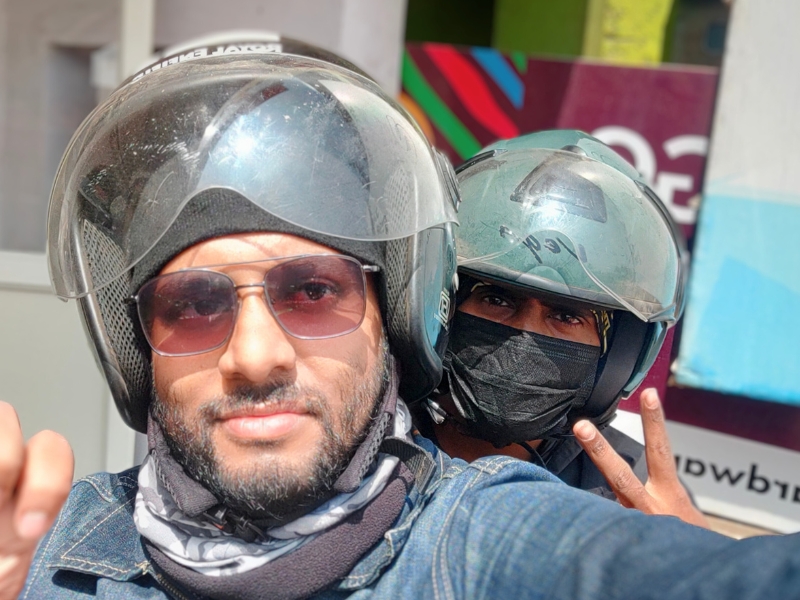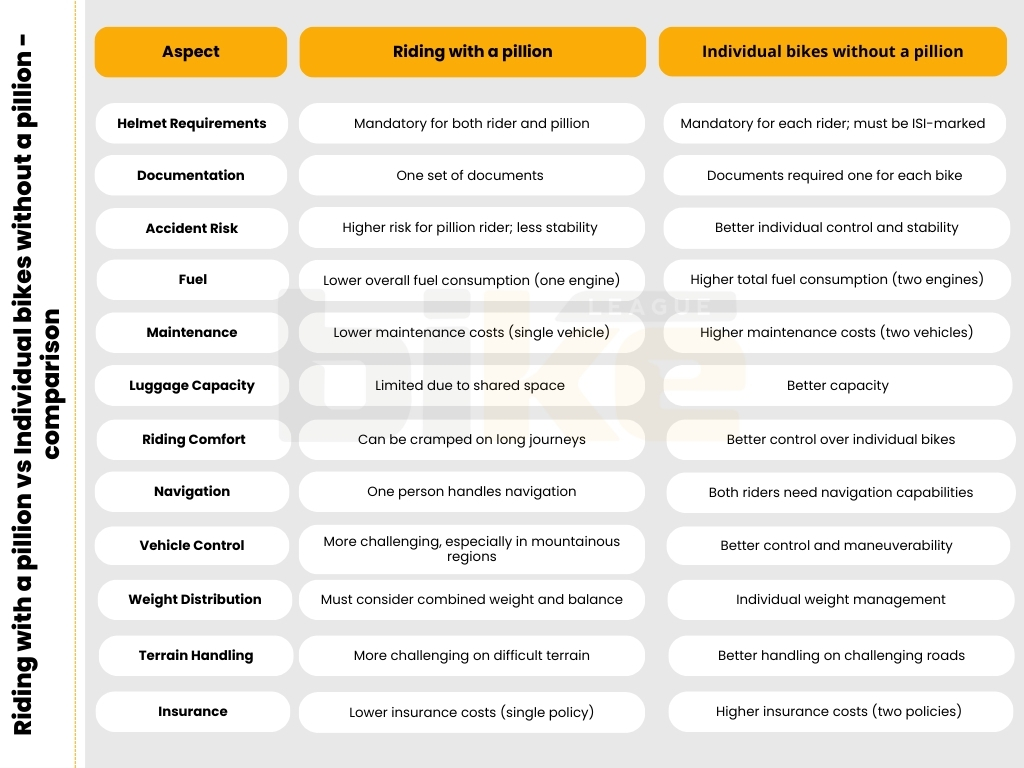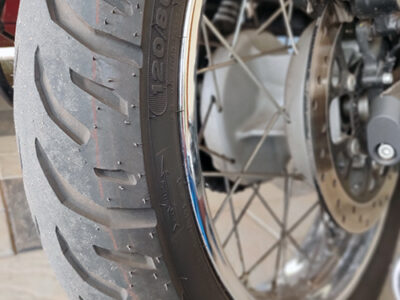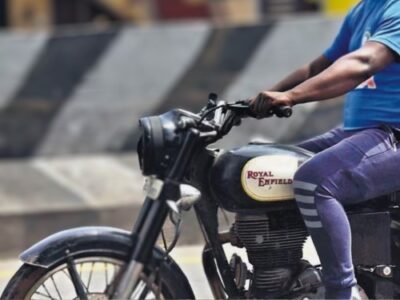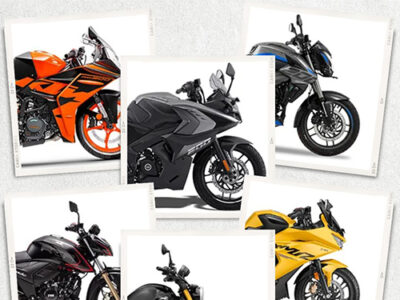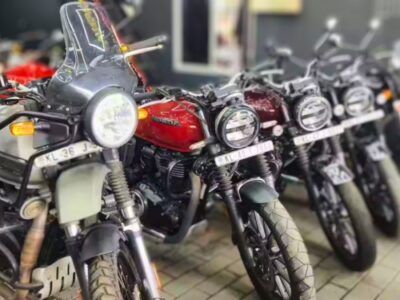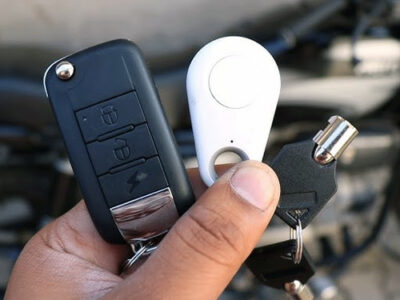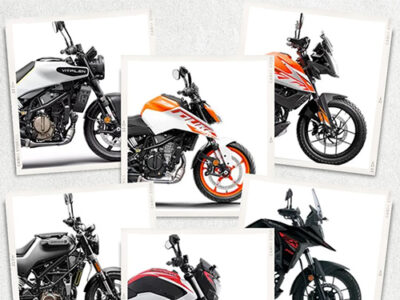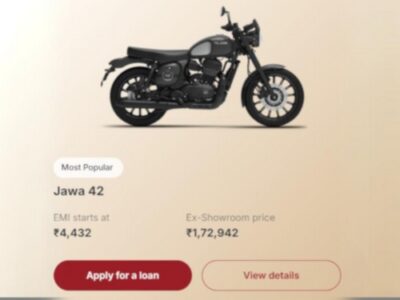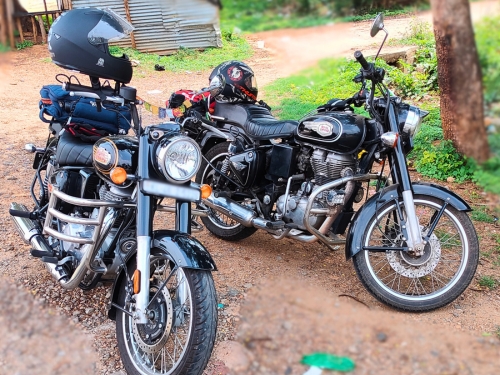
Long story short: Are you curious about the best way to ride on a motorcycle trip in India? Explore our insights on riding with a pillion versus going on individual bikes without a pillion for your next journey!
Motorcycle trips can be planned and enjoyed in various ways, and the ultimate aim is to travel, right? Yes, but what about riding configuration? We are not talking about riding accessories or anything like that. How many bikes and how many people are there in your trip plan?
Most people speak of group or solo riding; our team has a dedicated article for the same. Check out this link here. But what about riding with a pillion or individual bikes without a pillion? These are the other questions that come to mind while planning a trip. Also, please note that solo and individual bike riding without a pillion differ as there is more than one motorcycle here. In this article, we will discuss these aspects in detail.
1. Riding with a Pillion
Pros
- Shared fuel costs between rider and pillion make it more economical per person compared to riding two separate motorcycles
- Maintenance costs can be shared between both parties, reducing individual financial burdens
- Lower overall fuel consumption compared to two separate motorcycles.
- Creates opportunities for bonding and shared experiences
- Provides mutual support during emergencies
- Enhanced visibility to other road users due to a larger profile
- Practical assistance during mechanical issues or emergencies
Cons
- Higher vulnerability for pillion riders
- Increased risk of head and facial injuries, especially when helmets aren’t worn
- Side-saddle seating position (common among female pillions) significantly increases accident risk
- Additional weight affects motorcycle handling and performance
- Requires specific suspension adjustments and tyre pressure modifications
- May need seat modifications and proper handhold installation
- Increased wear on tyres, brakes, and suspension components
Regulations
- Mandatory helmet use for both rider and pillion under Section 129 of the Motor Vehicles Act
- Maximum of one pillion rider allowed per motorcycle
Communication and Coordination
- Direct communication between rider and pillion
- Easier coordination for stops and route changes
- Immediate feedback on comfort and needs
- Shared decision-making during the journey
2. Individual bikes without a pillion
Pros
- Better manoeuvrability and control for each rider
- Individual freedom to choose riding style and pace
- Reduced risk associated with weight distribution issues
- Greater stability and handling for each motorcycle
- Individual control over riding position and comfort
- There is no compromise on seating space
- Better temperature management (especially in hot Indian weather)
- Freedom to take breaks as needed
Cons
- Double fuel consumption as two engines are running
- Individual maintenance costs for each motorcycle
- Separate insurance and registration expenses
- Individual gear requirements increase the overall cost
Regulations
- Each rider must have a valid driving license and documentation
- Individual responsibility for traffic rule compliance
- Separate insurance and registration requirements for each vehicle
Communication and Coordination
- Requires communication systems or pre-planned protocols
- There is a need for clear hand signals and group riding formation
- Regular stops to ensure group cohesion
- More complex coordination for route changes or emergencies
What specific adjustments should be made to the motorcycle for riding with a pillion in India?
When preparing your motorcycle for riding with a pillion passenger in India, several specific adjustments and considerations are essential to ensure safety and comfort for both the rider and the passenger.
1. Weight Distribution and Suspension Adjustments
Carrying a pillion adds extra weight, affecting the motorcycle’s handling. It’s crucial to adjust the suspension settings to accommodate this additional weight. This may involve:
Increasing the preload on the rear shock absorbers to maintain proper ride height and stability.
Adjusting damping and rebound settings ensures the bike handles well under the extra load.
2. Tyre Pressure
Check and adjust the tyre pressure according to the manufacturer’s recommendations for riding with a pillion. Proper tyre pressure is vital for maintaining grip and stability, especially when carrying extra weight.
3. Footpegs and Seating
Ensure that the footpegs are positioned correctly for the pillion rider. They should be easily accessible and comfortable. Additionally, if your motorcycle has a dedicated pillion seat, ensure it is well-padded and secure.
4. Safety Gear
Both the rider and the pillion should wear appropriate safety gear. This includes:
- Helmets: Both riders must wear helmets that meet safety standards.
- Protective Clothing: Encourage the pillion to wear protective jackets, gloves, and sturdy footwear to minimise injury risk in case of an accident.
5. Riding Techniques
Adjust your riding style when carrying a pillion:
- Smooth Acceleration and Braking: Avoid sudden movements. Gradual acceleration and braking help maintain balance and comfort for the pillion.
- Communication: Establish signals with your pillion for when to lean or brace themselves, especially during turns or sudden stops.
What hand signals are recommended for rides on separate motorcycles in India?
Using hand signals while riding motorcycles is essential for communication. Here are some key hand signals that are commonly recommended for riders in India:
1. Left Turn Signal
Extend your left arm straight to the side to indicate a left turn. This universally recognised signal helps inform other riders of your intended direction.
2. Right Turn Signal
For a right turn, you can either extend your right arm straight out or use your left arm by bending it at the elbow and pointing upwards. The latter is often preferred in India due to traffic positioning.
3. Stop Signal
Extend your left arm downwards with your palm facing back to signal that you are stopping. This signal alerts other riders to slow down or stop as well.
4. Hazard Warning
If there is a hazard on the road, point with your left hand toward the hazard. For example, if the hazard is on the left side, point left; if it’s on the right, you can use your right hand to indicate.
5. Slow Down Signal
To indicate that the group should slow down, extend your left arm downwards with your palm facing back, similar to the stop signal but with a more relaxed posture.
6. Double File Signal
When riding two-by-two, raise two fingers on your left hand. This signal helps organise into a more compact formation.
7. Police or Speed Trap Warning
To warn others about a police speed trap, extend your left arm to the side and repeatedly pat the top of your helmet with your hand. This is a standard signal among riders to promote safety.
What additional insurance considerations exist when riding a motorcycle with a pillion passengers in India?
When riding with a pillion passenger in India, there are several essential insurance considerations to keep in mind to ensure both the rider and passenger are adequately protected:
1. Pillion Rider Coverage
Make sure your motorcycle insurance includes coverage for pillion riders. According to IRDAI rules and the Indian Motor Act, third-party bike insurance must cover damages for both the rider and pillion passengers in case of an accident.
2. Comprehensive Insurance Benefits
While third-party insurance is mandatory, comprehensive insurance offers better protection. This policy covers third-party liabilities and compensates pillion riders for injuries, accidental death, or permanent disability.
3. Additional Premiums for Enhanced Coverage
Consider adding covers specifically for pillion passengers, which may require extra premiums. These add-ons enhance coverage for events like accidental death or disability, ensuring better protection for both riders and passengers.
4. Legal Compliance
Ensure that your insurance policy complies with legal requirements for covering pillion passengers. This protects you from liabilities in case of an accident.
5. Communication with Insurer
Before carrying a pillion passengers, check with your insurance provider about coverage limits, exclusions, and the claims process for passenger injuries. This helps prevent complications if an accident occurs.
FAQ related to ride with a Pillion or Individual Bikes without a pillion in India
1. What are the legal requirements for pillion riding in India?
According to the Motor Vehicles Act:
- Both rider and pillion must wear helmets
- Only one pillion rider is legally allowed per motorcycle
- Riders must be above 18 years old for motorcycles with gears
2. How does pillion riding affect motorcycle handling?
The presence of a pillion significantly impacts handling:
- Added weight degrades handling and can make the motorcycle dangerous to ride
- It affects the motorcycle’s balance and manoeuvrability
- Requires more power to maintain speed
- Increases fuel consumption due to additional load
3. What safety gear is essential for both rider and pillion?
Required safety equipment includes:
- DOT-approved helmets for both rider and pillion
- Proper protective clothing
- Valid documentation for both in case both persons are riding in separate intervals (license, registration, insurance, PUC certificate)
- Reflective gear for night riding
4. What common mistakes should be avoided when riding with a pillion?
Common errors include:
- Not adjusting the suspension for additional weight
- Poor communication between rider and pillion
- Sudden movements by the pillion
- Improper weight distribution
- Not having optimum tyre pressure
5. How does riding with a pillion affect fuel efficiency?
The addition of a pillion rider significantly impacts fuel consumption due to several factors:
- Increased overall weight requires more power to maintain speed, leading to higher fuel consumption
- The engine needs to work harder to overcome the additional inertia and rolling resistance
- The impact is particularly noticeable during acceleration and uphill riding
6. What specific communication systems are recommended for rides on separate motorcycles?
Bluetooth intercom systems are among the most popular choices for motorcycle communication. They allow riders to communicate hands-free while riding, which is crucial for maintaining focus on the road. Many models support multiple riders, enabling group communication. For instance, systems like the Fodsports M1S Pro can connect up to 8 riders and offer features like music sharing and GPS navigation integration.
Other related articles from Bikeleague India
- Solo motorcycle rides vs. group rides in India: Pros & cons
- Must have bike accessories for a long distance trip
- Best bike trip routes in Kerala
- What all basic motorcycle accessories should a rider have
- Second hand motorcycle: Things to know when buying It
Conclusion
Choosing between a trip with a pillion and having two separate motorcycles depends on various factors, including budget, safety preferences, and riding purpose. While pillion riding offers economic advantages and shared experiences, it has increased safety risks and technical considerations. Two separate motorcycles provide better control and individual comfort but at higher costs.
If you have other doubts or queries, email us at bikeleague2017@gmail.com or share your doubts or opinions in the comments section below. We are always eager to help and assist you. Also, here are several social media platforms of Bikeleague India to raise your suspicions.

